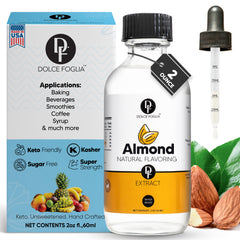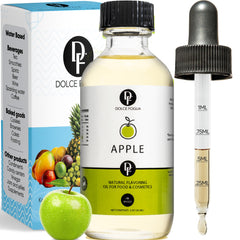
The answer to the question, "Is there really a perfect hard candy recipe?" is a definite YES! This recipe allows for customization of flavors and colors to suit your taste preferences. The secret to its success is the attention to detail and expertly crafted flavors.
In this recipe, we've added a special technique to achieve that classic hard candy texture that we all know and love. The best part? You don't have to worry about refrigeration. Simply store in a cool, dry place and enjoy your hard candies at your leisure.
The Flavor Difference Matters
What sets this hard candy recipe apart from the rest? The use of Dolce Foglia flavor concentrates is the key to its distinction. This ingredient brings a few benefits to the table:
Intensity: Flavor concentrates are more concentrated and stronger in flavor than extracts, meaning you can use less to achieve the desired flavor in your hard candies.
Consistency: Flavor concentrates tend to be more consistent in flavor and aroma from batch to batch, ensuring a consistent taste in your hard candies every time.
Solvent-free: Many flavor concentrates are made without solvents, making this recipe a great option for those seeking a natural, solvent-free candy making experience.
The History and Science of Hard Candy
The history of hard candy dates back to the Middle Ages, when sugar became more widely available and people began experimenting with different ways to use it. The process of making hard candy involves dissolving sugar in water and then heating it to a high temperature. The resulting mixture is then cooled and shaped into various forms. Hard candy has been enjoyed by people all over the world for centuries and has been used as a way to sweeten food and as a treat.
In terms of science, hard candy is a type of candy that is made primarily from sugar. Sugar is composed of glucose and fructose molecules, and when it is heated and dissolved in water, these molecules form a solution called a sugar syrup. As the syrup is heated further, the water evaporates and the sugar molecules begin to recrystallize, forming a solid mass. The temperature at which the syrup is heated, as well as the specific sugar used, will affect the final texture and consistency of the candy.
Acids in Hard Candy Making: Unlocking Flavor and Texture
Acids also play an important role in the science of hard candy making. They help to enhance the flavor of the candy and also affect the texture by making the candy less sticky and more brittle. This is because of the chemical reaction between the acid and sugar, which causes the candy to become more acidic and less alkaline. Some examples of acids that can be used to flavor hard candy include citric acid, malic acid, and tartaric acid.
Hard candy making is a complex process that involves both the art and science of candy making. Understanding the history and science behind the process can help you to make better quality candy, and create unique and delicious flavors.
A Delicious Hard Candy Recipe with Dolce Foglia's Unique Flavors:
- 2 cups granulated sugar
- 1/2 cup corn syrup
- 1/4 cup water
- 1/4 tsp citric acid
- 1 tsp DF flavoring
- Food coloring (optional)
Instructions:
- In a large saucepan, combine the sugar, corn syrup, and water. Stir until the sugar has dissolved.
- Add in the citric acid and unique flavoring, and stir until well combined.
- Bring the mixture to a boil over medium-high heat, and continue to cook until it reaches the hard crack stage (around 300-310°F on a candy thermometer).
- Remove from heat, and add in food coloring if desired.
- Pour the mixture into a greased candy mold or onto a greased surface, and let it cool completely.
- Once the candy has hardened, remove it from the mold or break it into pieces.
DF flavoring in this recipe can really elevate the taste and experience of the hard candy. Experimenting with different flavors can help you to create new and exciting candy products. Whether you're making candy at home or on a commercial scale, be sure to use high-quality ingredients and follow proper food safety procedures for the best results.
Hard Candy FAQ's
Can hard candy go bad?
While it has no nearby termination dates (basically none) hand crafted candy can in any case turn sour however because of reasons, you may not think. Moistness, temperature control, stockpiling, and different things generally become an integral factor on the time span of usability of treats. Your candy as it ages will turn out to be delicate, tacky, chewy, and gooey so it's ideal to appreciate it when it's at its freshest for best outcomes.
Can hard candy be frozen?
While you could freeze it, I don't suggest doing as such. Hard candy once it starts to defrost will sob and turn into a tacky wreck. Hence, I strongly suggest staying away from freezing.
Will hard treats adhere to material paper?
Your hard candy shouldn't adhere to the material paper since material paper is planned and made to endure such plans.
For what reason is my hard candy chewy?
A great deal of elements could be affecting everything for making your candy chewy all things being equal or hard as wanted. For instance, the capacity and room's humidity levels could be factors, yet another is the way you made the sweets.
On the off chance that you didn't permit the candy to get to the appropriate temperature prior to filling the container or molds, the candy might not have arrived at the legitimate hard-ball stage expected to hold a hard surface once cooled.
What is a hard-ball stage?
Hardball stage is the name given to the piece of the sugar/water bubbling cycle when the sugar comes to around 260 degrees F and can be dropped in minuscule sums into a compartment of super cold water and quickly ball up in shape.
It generally takes around 10-12 minutes to arrive at this point while heating up the blend and it's exceptionally useful to have a treats thermometer available for following the hotness of the combination as we need to go beyond this point and carry our blend nearer to that 300 degrees F point.
*****
If you're interested in a gummy recipe, check out his blog!




